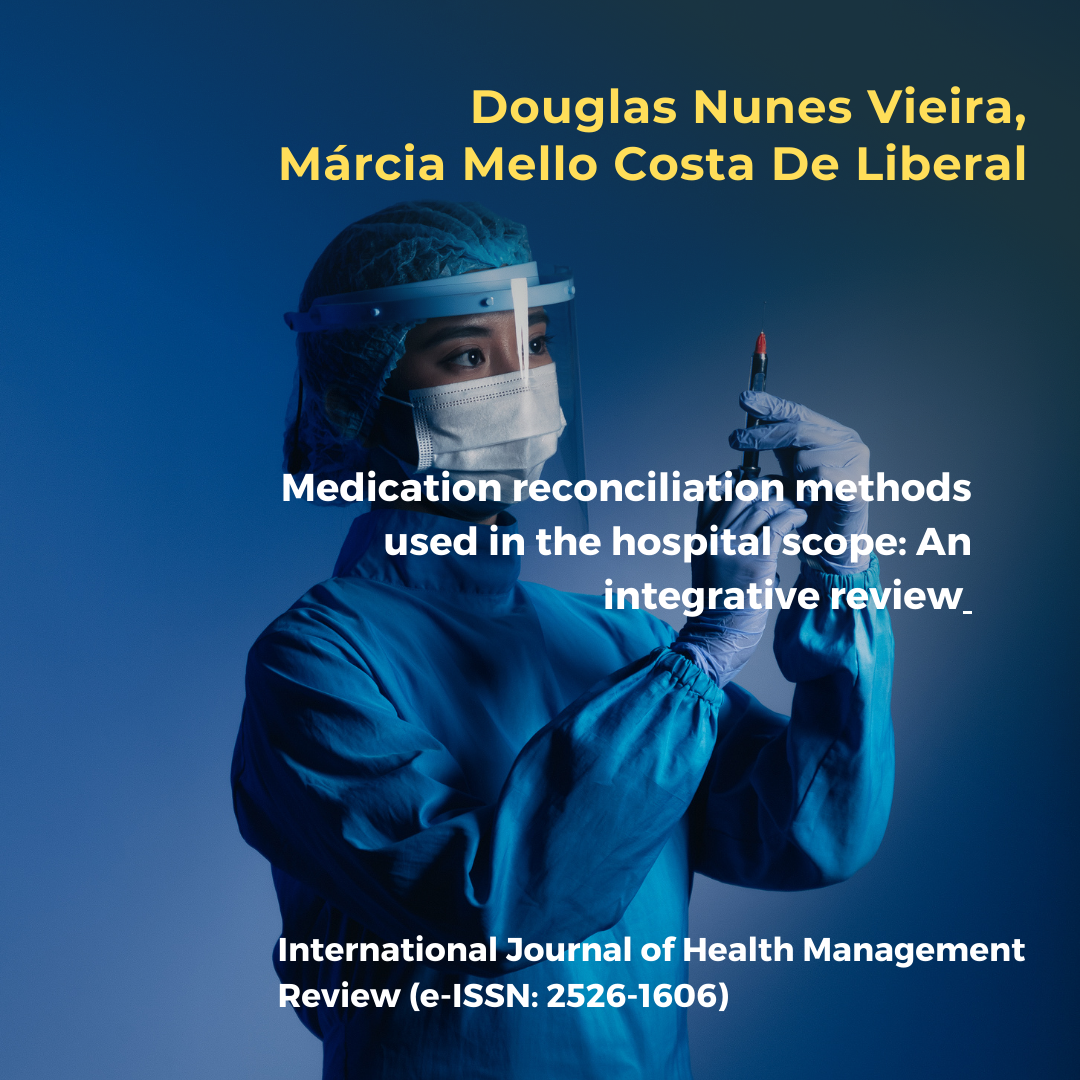Métodos De Reconciliação Medicamentosa Empregados No Âmbito Hospitalar: Uma Revisão Integrativa
DOI:
https://doi.org/10.37497/ijhmreview.v9i00.329Palavras-chave:
Medication Reconciliation, Pharmaceutical Service, HospitalResumo
Medication Reconciliation (RM) is a systematic and formal process that consists of obtaining and comparing the complete and accurate list of prehospital pharmacotherapies with the hospital medical prescription (on admission, transfer, and discharge), leading to the detection of medication errors (discrepancies). This article aims to identify which medication reconciliation methods are used in hospitals through an integrative review. The results revealed that, out of 12 articles, only 10 cite the use of electronic tool methods, such as electronic medical records, applications, electronic medical records, multimedia software, and toolkit. Electronic tool methods are widely embedded and employed in medication reconciliation in a variety of ways. In conclusion, we highlight that, although electronic methodologies are widely inserted and disseminated as solutions for medication reconciliation, it is unusual. Ideally, a combination of different MRI methods should be combined, according to the reality of each institution, such as a targeted interview with the patient or caregiver, associated with electronic methods to obtain better quality medication reconciliation with better results.
Referências
AFONSO, Renata. Reconciliação de terapêutica. Revista Clínica do Hospital Prof. Doutor Fernando Fonseca, v. 3, n. 1, p. 35-36, 2015.
BOTROS, Shady; DUNN, John. Implementation and spread of a simple and effective way to improve the accuracy of medicines reconciliation on discharge: a hospital-based quality improvement project and success story. BMJ Open Quality, v. 8, n. 3, p. e000363, 2019.
BULAJEVA, Anna et al. Medication review practices in European countries. Research in Social and administrative pharmacy, v. 10, n. 5, p. 731-740, 2014.
Centro de Informação do Medicamento (CIM). Reconciliação da medicação: um
conceito aplicado ao hospital. Boletim do CIM. ROF, n. 106, Jan./Mar. 2013.
AMCP PARTNERSHIPS FORUM. AMCP Partnership Forum 2013 Report on Electronic Solutions for Medication Reconciliation and Improving Care Transitions. Journal of Managed Care Pharmacy, v. 20, no. 9, p. 937-947, 2014.
GARCÍA‐MOLINA SÁEZ, C. et al. Computerized pharmaceutical intervention to reduce reconciliation errors at hospital discharge in Spain: an interrupted time‐series study. Journal of Clinical Pharmacy and Therapeutics, v. 41, n. 2, p. 203-208, 2016.
GIMÉNEZ-MANZORRO, Álvaro et al. Effectiveness of an electronic tool for medication reconciliation in a general surgery department. International journal of clinical pharmacy, v. 37, p. 159-167, 2015.
HEPLER, Charles D.; STRAND, Linda M. Opportunities and responsibilities in pharmaceutical care. American journal of hospital pharmacy, v. 47, n. 3, p. 533-543, 1990.
JURADO, Camille et al. The Electronic Pharmaceutical Record: A new method for medication reconciliation. Journal of Evaluation in Clinical Practice, v. 24, n. 4, p. 681-687, 2018.
KETCHUM, Kathy; GRASS, Christine A.; PADWOJSKI, Anne. Medication Reconciliation: Reviewing medication orders and clarifying discrepancies should be standard practice. AJN The American Journal of Nursing , v. 105, n. 11, pág. 78-85, 2005.
LEE, Audrey et al. Value of pharmacist medication interviews on optimizing the electronic medication reconciliation process. Hospital pharmacy, v. 49, n. 6, p. 530-538, 2014.
LESSELROTH, Blake J. et al. Naturalistic Usability Testing of Inpatient Medication Reconciliation Software. In: ITCH. 2017. p. 201-205.
MARIEN, Sophie; KRUG, Bruno; SPINEWINE, Anne. Electronic tools to support medication reconciliation: a systematic review. Journal of the American Medical Informatics Association, v. 24, n. 1, p. 227-240, 2017.
MEYER, Carolyn et al. How reliable are patient-completed medication reconciliation forms compared with pharmacy lists?. The American journal of emergency medicine, v. 30, n. 7, p. 1048-1054, 2012.
MIXON, Amanda S. et al. Design of MARQUIS2: study protocol for a mentored implementation study of an evidence-based toolkit to improve patient safety through medication reconciliation. BMC health services research, v. 19, n. 1, p. 1-10, 2019.
MUNCK, Lars K. et al. The use of shared medication record as part of medication reconciliation at hospital admission is feasible. Family doctor, v. 9, p. 7, 2014.
PEREIRA, Leonardo Régis Leira; FREITAS, Osvaldo de. A evolução da Atenção Farmacêutica e a perspectiva para o Brasil. Revista Brasileira de ciências farmacêuticas, v. 44, p. 601-612, 2008.
STOLLDORF, Deonni P. et al. Implementation and sustainability of a medication reconciliation toolkit: a mixed methods evaluation. American Journal of Health-System Pharmacy, v. 77, n. 14, p. 1135-1143, 2020.
TAMBLYN, Robyn et al. Improving patient safety and medication reconciliation efficiency through the development and adoption of a computer-assisted tool with automated electronic integration of population-based community medication data: the RightRx project. Journal of the American Medical Informatics Association, v. 25, no. 5, pg. 482-495, 2018.
VILLAMAYOR-BLANCO, Lucía et al. Conciliación de medicación al ingreso mediante un programa de prescripción electrónica asistida. Farmacia Hospitalar, v. 40, n. 5, p. 333-340, 2016

Downloads
Publicado
Como Citar
Edição
Seção
Licença

Este trabalho está licenciado sob uma licença Creative Commons Attribution-NonCommercial 4.0 International License.
Autores que publicam nesta revista concordam com os seguintes termos:
O(s) autor(es) autoriza(m) a publicação do texto na da revista;
O(s) autor(es) garantem que a contribuição é original e inédita e que não está em processo de avaliação em outra(s) revista(s);
A revista não se responsabiliza pelas opiniões, idéias e conceitos emitidos nos textos, por serem de inteira responsabilidade de seu(s) autor(es);
É reservado aos editores o direito de proceder a ajustes textuais e de adequação às normas da publicação.
Autores mantém os direitos autorais e concedem à revista o direito de primeira publicação, com o trabalho simultaneamente licenciado sob a Licença Creative Commons Attribution que permite o compartilhamento do trabalho com reconhecimento da autoria e publicação inicial nesta revista.
Autores têm autorização para assumir contratos adicionais separadamente, para distribuição não-exclusiva da versão do trabalho publicada nesta revista (ex.: publicar em repositório institucional ou como capítulo de livro), com reconhecimento de autoria e publicação inicial nesta revista.
Autores têm permissão e são estimulados a publicar e distribuir seu trabalho online (ex.: em repositórios institucionais ou na sua página pessoal) a qualquer ponto antes ou durante o processo editorial, já que isso pode gerar alterações produtivas, bem como aumentar o impacto e a citação do trabalho publicado (Veja O Efeito do Acesso Livre) em http://opcit.eprints.org/oacitation-biblio.html














